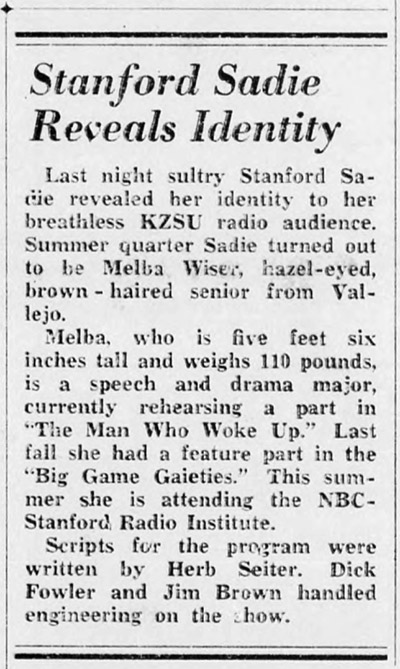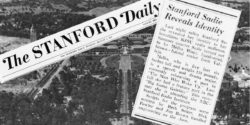Editor’s Note: This is the final installment of Fred Krock’s three-part series on San Francisco Bay Area radio in the early 1950s. In part one he gave an overview of what the radio dial sounded like. Fred attended Stanford University at that time, and began recounting how he got involved in the station in part two. In this conclusion he reflects on the station’s programming, staffing, and other aspects.
In the early 1950s Stanford University’s KZSU was block programmed like most radio stations. “Cardinal Classics” with classical music was broadcast 8 to 9 PM every night. Occasionally KZSU would broadcast a one-hour radio play at 9 PM. Staff members were the actors, though sometimes speech and drama students acted.
The station had a sound effects cart with devices like door latches and hinges to make sound effects used during the play, as well as a telephone to create telephone sounds. There were variable speed turntables and a good library of sound effect records. The fidelity of these records was not very good since many had been recorded from movie soundtracks, and some discs were worn out. Sound came out of a loudspeaker in the studio that was picked up by studio microphones, which meant actors did not have to wear earphones to react in synchronization with the sounds.
There I learned a valuable lesson about sound effects. The sound of a baby crying was needed for a drama show, but none of the records provided this, and none of our actors could imitate a crying baby very well. So I took a tape machine and recorded the crying niece of one of our staff members who lived in San Carlos. We had the high fidelity sound of a crying baby. But on the air that accurate sound distracted from the story we were trying to tell. I learned that a sound effect works better if it suggests the sound rather than being an extremely accurate copy.
At NBC, NABET union engineers had jurisdiction of sound effects and one of the middle aged engineers on their San Francisco staff could perfectly imitate a crying baby. So he provided all baby sound effects. AFTRA, the announcer’s union, did not have jurisdiction, even though he was on the air, since these were sound effects, not speech.

Story from The Stanford Daily, August 5, 1952
On Monday at 10:30 PM KZSU had its major show, “Stanford Sadie.” Every quarter a different woman read the script, and her real name was kept secret until her final broadcast of the quarter. Sadie was inspired by actress Mae West. Usually the actress playing Sadie wrote her own script, but sometimes she was not able to write enough of them. Then other staff members wrote them for her; I even had to write some.
The challenge was seeing how close the suggestive and raunchy copy could get to obscenity without actually going over the line. Needless to say, our faculty advisor paid very close attention to “Stanford Sadie” scripts.
On a typical “Sadie” broadcast she would talk about something like the importance of size in different parts of male anatomy. After much discussion with lots of double entendres about elbows, ankles, noses and such, Sadie decided that ears were the most important part so a man could hear her say, “Let’s make love.” Both men and women enjoyed listening to “Sadie,” while the women were trying to guess who she really was.
The KZSU studio even had a piano. At one time the FCC required all radio stations to be able to broadcast live music, resulting in most stations having them. A few stations featured a Hammond electric organ, first manufactured in 1935, and NBC in San Francisco had a theater pipe organ in one studio.
On KZSU one male student would broadcast a 15 minute show once a week while he played the piano and sang seated at the keyboard. He was a very talented musician although he was not a music major. KZSU also broadcast other live music programs.
KZSU did not have regular newscasts most of the time. However the Intercollegiate Broadcasting System made a deal where it would supply the United Press news service in exchange for advertising time. So, for a while KZSU had a teletype machine rattling away in the office.
KZSU broadcast sports only when a staff member wanted to be a sportscaster. There were circuits to a locations like the football stadium, baseball field, and basketball gymnasium, putting to good use the station’s new GE remote amplifier. One staff member with a very heavy Brooklyn accent did a lot of play by play announcing. I even tried announcing baseball.
Surplus Ingenuity
I built an echo chamber in an otherwise unused empty room with concrete walls in the basement of MemAud so reverberation could be mixed with live music studio shows. It also was used for effects, like the voices of ghosts on drama shows. A loudspeaker played music while a microphone picked up the reverberant sound that was mixed back into the original source. NBC in San Francisco had two echo chambers. Digital reverberation generators were about 40 years away.
On the Stanford campus one boiler plant provided steam for most classroom and dormitory heating. The steam pipes were routed through underground tunnels all over the campus. Following the war the federal government gave military surplus items to schools and colleges, and Stanford had received many miles of Army field telephone wire. It was installed from the KZSU studios through the steam tunnels to many different places on campus, so the station could broadcast music concerts or lectures from any place on campus very easily.
Much of the rest of the KZSU shows used records. The station had a library of about 5,000. There were several different types of jazz programs, but some of the DJs wanted to play current popular songs. This was a problem since KZSU did not have any budget to purchase records and was unable to make a trade deal with a local record store. Most record companies would not send free records to college stations. One company that did send free records issued rhythm and blues music that we never used.
Burgermeister Beer sponsored “The Burgie Music Box” every night on the station that today is KNBR. It had a very good sounding transmitter and did no extreme audio processing, so KZSU just recorded the Burgie show on tape. The station had a very good recording lathe along with the budget to purchase blank recording discs, and the engineers recorded the popular songs from “The Burgie Music Box” show on 16 inch transcription discs.
They were known by the staff as “Z discs” because the letter Z was a prefix to the file number. Each Z disc typically had twelve different popular songs on it. KZSU listeners never knew they were listening to a recording from a radio program rather than an original phonograph record.
Covering Campus
At Stanford all undergraduate women and all male freshmen were required to live on campus. An exception was made for students with a family living nearby, who could live at home. Some men lived in fraternity houses, but the school had banished sororities and all the former sorority houses had been converted into dormitories. KZSU served all these locations.
Stanford Research Institute (SRI) was located in Menlo Park, on part of a former military base. Some students even lived in the original army housing, so KZSU leased a program line from Pacific Bell and fed programs to a carrier current transmitter at SRI.
Stanford did not have enough dormitory space for all male sophomores, juniors, and seniors, therefore many lived off campus and could not hear KZSU. There also was housing for married graduate students near College Park. They also did not hear the station.
KZSU Staff
KZSU staff members came from many different disciplines on campus. Future electrical engineers installed and repaired technical equipment, like the station’s Ampex and Magnecorder tape recorders. The National Association of Broadcasters tape recording standards had not yet been created in the early 50s, which meant tapes made on the two recorders were not compatible with each other. That’s why an electrical engineer later modified the Magnecorder so its tapes were compatible with the tapes recorded by the Ampex machine. He also modified the Magnecorder controls so that it operated in the same way as the Ampex. He guessed right because Ampex became the industry standard.
Two KZSU engineers went to work for Ampex after they graduated, and both became very well known in the Audio Engineering Society. One had been my roommate for two years and became a worldwide authority on tape recording.
Some women worked on secretarial and office jobs at KZSU, typing letters and filing things. They went to staff parties but they were never on the air. Nevertheless, broadcasting must have been in their blood. One became a lawyer and was a public defender in Spokane, Washington. Many years later she was a volunteer working on pledge drives for the local NPR station.
Only a very tiny percentage of staff members ever intended to make a career in broadcasting, but being an announcer was a dream for many boys like wanting to be a railroad engineer. One KZSU announcer had been part of a high school group that broadcast school news on Saturday mornings in Houston, Texas (there’s that FCC educational program requirement in action). He was an excellent announcer and could have gotten a job at a major market station, but he did not make a career of broadcasting.
Personal Reflections
Now here are a few personal observations. The on-air people on KZSU for the most part imitated what they heard on the air elsewhere. All the jazz disc jockeys imitated Jimmy Lyons who announced a late night program on what is now KNBR. (The program originated from the Hangover Club bar in San Francisco. NBC censors had problems with the club name so it became the Hannover Club on the air.) Lyons had a very different, distinctive, and idiosyncratic delivery. He ruined a whole generation of future jazz announcers, in my opinion.
KZSU was not a slave to audience ratings. Staff members had the possibility to experiment with all kinds of unusual different experimental programs, but they did not. This was true at many other college stations, not just at Stanford. We had a wonderful opportunity, but we wasted it.



